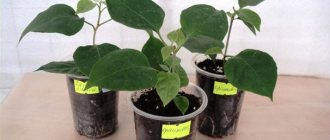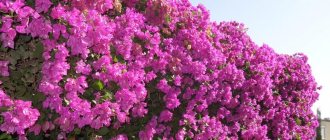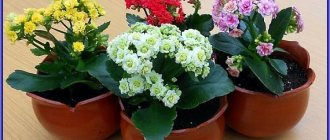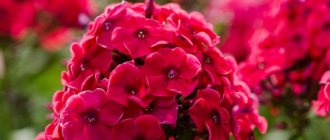The beauty of Bougainvillea is not lost and amazes the imagination even against the backdrop of the lush splendor of the flora of the southern countries. It looks harmonious both in wildlife and in landscape design. Unfortunately, Bougainvillea is a plant that requires certain weather conditions to grow and care for in open ground. It can be cultivated outdoors and in the garden all year round only in regions with a warm climate.
Climatic conditions for growing Bougainvillea outdoors
Growing Bougainvillea garden in open ground is possible only in countries with a warm tropical climate. It does not tolerate cold and even when the air temperature drops below +5 °C it begins to get sick, and at 0 °C it can die. In Russia, climatic conditions suitable for this exotic are found only in Crimea in the southernmost regions of the peninsula. In other regions of our country, pot cultivation of heat-loving exotics is used and taken outside during the warm season.
With this method of care and maintenance, plants growing in a house or greenhouse in tubs or large pots are wintered indoors or in protected ground with a controlled climate. In late spring or early summer, when the threat of frost has passed, they are moved to fresh air and left in the garden as long as the weather is warm. Sometimes the tubs are buried, creating the illusion that the potted tree or shrub is growing directly from the ground. For example, Bougainvillea is cultivated in the Moscow region, in the southern Urals and some other regions of our country.
When taking a plant outside, you need to install the tub once; you cannot even turn it, changing the direction of the branches. Otherwise, the Bougainvillea will stop blooming and shed its leaves.
General idea of bougainvillea culture
A climbing vine from the family. Nociformes, widespread in South America, have also attracted interest from floriculture lovers in Russia. In the natural environment it can be represented by different life forms: liana, shrub or small tree. More often it is a shrub with clinging shoots. Due to the thorns on the stem, bougainvillea holds onto its support.
The shoots grow very quickly, capable of stretching up to 5 m. The leaf blade is oval, the ends of the leaves are pointed. During the flowering period (from May to November), they are hidden under a screen of bright stipules. Bougainvillea is grown as a large container plant for a winter garden, greenhouse or indoor conditions. In culture, the two most famous species are Bougainvillea glabra (naked) and Bougainvillea spectabilis (wonderful).
The flowers are inconspicuous and inconspicuous; the decorative appearance of the plant is provided by bracts (bacteria), which have a wide variety of colors. There are two-color varieties, as well as varieties that can change color during flowering. The variegated leaves also add decorativeness to the vine. Breeders dream of breeding bougainvillea without thorns and with blue stipules, but so far this is just a dream. Although the few modern varieties in cultivation are amazing.
Choosing a place and landing
In order for Bougainvillea to develop well and bloom profusely on the street or in the garden, it needs to be provided with conditions as close as possible to its usual habitat. Under natural conditions, the heat-loving beauty usually grows on sunny rocky slopes. Therefore, when choosing a location for it, the following factors should be taken into account:
- the planting area should be well lit, protected from the wind, and free from other trees and shrubs;
- the soil on the site should be well aerated, drained, dense, neutral or slightly alkaline.
If garden soil for Bougainvillea does not meet these criteria, you can buy it in a specialized store or mix it yourself, from equal proportions of peat, turf soil, sand and humus.
Bougainvillea is planted in open ground in the spring, when stable warm weather is established outside, by cuttings or bushes, in pre-prepared holes. Before planting a plant, you need to make sure that their depth is sufficient so that a drainage layer can be laid on the bottom. Soil mixed with humus is poured onto the drainage and a seedling is placed. The soil around it needs to be lightly compacted and then watered abundantly.
Origin and appearance of the bougainvillea plant
In its homeland in South America, this tropical plant blooms 9 months a year. Gardeners from different countries fell in love with it for its unusual shape. Now it can be found in Europe, Asia and in our country.
Bougainvillea adds special decor to the home, quickly creating flower arches
Note! The plant was named in honor of the French traveler and explorer Louis Antoine de Bougainville.
Description of the flower
In natural conditions, bougainvillea liana clings to natural or artificial supports with creeping branches with thorns, its shoots grow in any direction.
The structure of the inflorescence is interesting: the flowers themselves are small white on a thin long stalk, grouped in 2-3 pieces. Large petals, brightly colored, paper-like, are bracts. They are located very densely and in some places completely obscure the leaves.
The bougainvillea flower looks like the product of a talented needlewoman
Features of caring for Bougainvillea in the garden
Bougainvillea is an exotic beauty, growing and caring for it in the open ground is quite a troublesome task. But if climatic conditions allow and the basic rules of its maintenance are followed, it will delight with bright, abundant flowering 9 months a year in seasonal cycles of 4 to 6 weeks.
In the first 2-3 years in open ground, Bougainvillea actively grows and accumulates green mass, but does not bloom. It reaches its maximum decorativeness at the age of 4-5 years.
Temperature
Bougainvillea loves warmth. Even in the favorable California climate, when grown outside, there is still a risk of freezing. Therefore, those who are planning to grow a southern beauty should take into account what the temperature necessary for its harmonious development should be. Its parameters are as follows:
- in summer, during flowering - +21-27 °C;
- in spring at the beginning of the growing season - above + 10 °C;
- The minimum temperature of the earth's coma is +5 °C.
If in winter the plants placed outside in pots and tubs for the summer are kept in warm conditions, the dormant period will not occur, but in the summer their flowering will be weak.
Watering
Water for irrigation is taken warm and settled. An important condition is maintaining water balance. It is recommended to water abundantly, but not excessively: the soil should not become waterlogged, but drying out of the top layer is also undesirable.
In summer, Bougainvillea is watered 2 times a week, in the morning. With the arrival of autumn and until the next flowering, the frequency of watering is reduced, making sure that the soil around the trunk does not become too dry. If the plant has lost its leaves, watering must be stopped completely.
In hot, dry weather, green leaves are sprayed with warm water, while care must be taken to ensure that the bracts remain dry. During prolonged rainfall, in order to prevent rotting of the root system, it is better to protect the bush from excess moisture.
Top dressing
From April to September, Bougainvillea has a period of active growth, and during this time the plant needs to be fed. Every spring it is recommended to add humus under the bushes. In addition, for young seedlings, once every two weeks it is recommended to apply a complex of mineral or special fertilizers for flowering plants. They are scattered around the bush, and then the ground is loosened.
Starting from the second year, fertilizing is applied once every two months. In this case, preference should be given to those that contain potassium, iron and phosphorus. But you should be careful with nitrogen fertilizers; they can provoke an increase in green mass to the detriment of flowers and bracts.
Nitrogen fertilizers include: ammonium nitrate, ammonium sulfate, potassium nitrate, urea, sodium nitrate, calcium nitrate.
Crown trimming
Pruning young and skeletal branches allows you to form a beautiful crown and promotes lush and abundant flowering. If this is not carried out, the number of young shoots decreases, and as a result, the decorativeness of the plant as a whole decreases. Bougainvillea pruning in open ground is carried out in 3 stages:
- in the fall, before the start of the dormant period, the branches that have grown over the summer are shortened by half;
- in the spring, before the start of the growing season, bushiness is caused: lignified branches are cut to 10-13 cm;
- During the growing season, a crown is formed: branches that violate the intended composition and weak growth are removed.
When pruning, be sure to leave 5-7 cm of the current year's shoot. Dormant buds on old shoots are very difficult to awaken, and new shoots may not form.
Proper pruning of Bougainvillea consists of the following steps:
- Step 1. Prepare the necessary tools and materials: gardening gloves, pruning shears, disinfectant (bleach or medical alcohol).
- Step 2. To prevent the plant from becoming infected with diseases, wipe the pruning shears with a disinfectant.
- Step 3: Begin pruning by removing diseased, damaged or dead branches.
- Step 4. Before you start pruning healthy parts, re-disinfect the pruning shears with bleach or alcohol.
- Step 5. Remove branches that you think are unnecessary and those that were damaged during the pruning process.
- Step 6: Step back a few steps, carefully inspect the plant, and continue pruning until you achieve the desired shape.
- Step 7. Remove all cut branches from the area.
- Step 8. To encourage fruit set, repeat pruning throughout the growing season every 4-6 weeks or as needed.
- Step 9. Between regular prunings, pinch - manually tear off the wilted tops of the inflorescences.
- Step 10. After trimming a large number of branches, feed the Bougainvillea with complex fertilizer.
Advice from experienced gardeners:
- To prevent flowering from becoming less abundant or stopping altogether, do not prune your Bougainvillea too low.
- Remember to regularly remove wilted flowers. Remaining on the bush, they delay the formation of new buds.
- When working with bougainvillea garden, do not forget to wear work gloves. Thick branches and sharp thorns can hurt your hands.
As you master pruning Bougainvillea, keep in mind that pinching can be done at any time of the year and as often as you want. The more often you prune faded blossoms, the more new flowers will form on the plant.
You can choose the shape of the crown at your discretion: leave it to grow as a vine, form it into a bush, or graft it onto a standard.
Liana-shaped crown
To support the vine and make it aesthetically pleasing, it is necessary to select a suitable support. You can shoot shoots along the walls of a gazebo or house, purchase a suitable support in a specialized store, or make it yourself, for example, from wire, willow twigs, or bamboo stems. The shape of the support can also be varied: arch, lattice, wigwam.
Bush formation
To form a bush of a certain shape, a wire fence is installed around it. Young shoots are directed along the fence and are fixed to it as they develop. After the base of the form has been formed and the shoot has outgrown the fence by a few centimeters, pruning is carried out. Only the upper, young, green shoots are subject to formation. Lignified branches need to be cut off completely, as they are not suitable for crown formation.
Formation of a standard form
This method of cultivation may take several years. The first step is to determine the future height of the trunk and the desired crown diameter. A support corresponding to these dimensions is placed next to the plant. The cutting is carefully pulled to it and fixed. As soon as the cutting outgrows the support by a couple of centimeters, you need to pinch the growth point and then remove all the shoots from the standard stem. You can leave only a few upper branches, which will be the basis of the future crown. Pruning is carried out only for young shoots. When the crown is finally formed, remove all shoots that violate its boundaries. Over time, the trunk will become more powerful and will begin to resemble a tree trunk.
Creating man-made beauty with bougainvillea
An individual specimen of a tropical flower can last from one to 10 years under cultivated conditions. Bougainvillea reaches its maximum decorative value at the age of 4-5 years. The bushes planted in the soil of the greenhouse on the south side are especially beautiful. In summer they turn into flower avalanches. Compositions that include different colors are especially beautiful.
There is another way to use the effect of a single bush with different flowers.
Initially, several plants are planted in one tub, an intertwined trunk of several vines and a lush multi-colored bush are formed by pruning bougainvillea .
Unusual and fascinating with mystery, bonsai from naked bougainvillea. This variety lends itself perfectly to the formation of a standard. Arches made of vines, pergolas, gazebos, whatever the skillful hands of an artist can make from living material!
How to grow bougainvillea - video
Reproduction of garden Bougainvillea
Bougainvillea garden is propagated in three ways: layering, cuttings and seeds. Moreover, the most effective of them are the first two.
By layering
When propagating using layering, a young, low-lying shoot is selected. You need to make circular notches on it, bend it low to the ground and fix it in this position. With this method, regular and abundant watering of both the mother bush and the cuttings is recommended. You can separate the new plant from the mother plant immediately after rooting or next spring.
Cuttings
Cuttings from Bougainvillea garden are cut in late spring or early summer. You can take those that remain after formative pruning, but they must be lignified. The cut is made under the kidney. The shoots are cut into several pieces of 10-15 cm with 3-4 leaves, placed in settled water at room temperature for several hours, and then treated with a growth stimulator. After processing, the leaves, which should be located at the bottom of each cutting, are cut off. Each cutting is placed in a substrate of peat and sand, sunk into the ground up to the second internode, watered and covered with a jar or a mini-greenhouse is built. The room temperature must be maintained at 25 °C. Watering is no longer carried out, but the cuttings are ventilated and sprayed with water daily. A month later, when the roots have grown, it is planted in a permanent place.
Seeds
This is the most labor-intensive and time-consuming method. The seeds are found in pods inside dried bracts. They can only be collected from large, well-rooted plants. To obtain seedlings, seeds are sown in moist soil poured into a container from garden soil, peat and sand in a ratio of 2:1:1. A mini-greenhouse is best suited for germination. If it is not there, the soil is covered with film. From time to time, the substrate with seeds is slightly moistened. After the shoots appear and before they are picked, the film is opened for ventilation.
Temperature
The shrub reacts extremely sharply to changes in temperature. The flowering period in the native southern regions of bougainvillea is long - from May to November. It is quite difficult to organize similar conditions in the middle zone.
Reducing the temperature in winter should be as gentle as possible. But at the same time, keeping the flower at an artificial “summer” temperature all winter is also not recommended. In this case, the plant will bloom constantly, but weakly, and will not gain the necessary strength for summer splendor. Counting on the summer riot of flowering, in winter bougainvillea needs to ensure a state of sleep and rest. To do this, you need to place the plant in a dimly lit room with a low temperature, but not lower than plus five degrees Celsius at the roots.
Caring for bougainvillea outdoors in winter
As already mentioned, growing Bougainvillea in open ground is possible only in areas where the temperature of the earthen coma enveloping its roots does not fall below + 5 °C. In Russia, these are the southernmost regions of the Crimean peninsula. But even here there is no guarantee that Bougainvillea will not freeze in winter. Therefore, for the winter (in the coldest months), it is advisable to cover it with special material and cover the ground around the trunk with spruce branches.
With tub crops grown in colder regions, for example Bougainvillea in the Moscow region, everything is simple - so that the heat-loving beauty does not freeze, the tub or pot with it needs to be moved to a house or greenhouse at the end of August or early September.
Otherwise, caring for Bougainvillea in winter is not too difficult. Before the onset of cold weather, it is recommended to shorten the shoots by half. Watering in winter is not interrupted, but is carried out much less frequently than in summer, just so that the earthen ball does not dry out.
Bougainvillea in the middle zone - why not. Yes!
Bougainvillea is one of the most luxurious, bright, like summer itself, plants that decorate the cities of the warm southern seas almost all year round. How you want to take with you from your next vacation not only a set of souvenirs, but also this beautiful flower, its memorable sweet aroma!
And although the plant can bloom on an ongoing basis only on the Black Sea coast and in the Crimea, Russian gardening scientists guarantee the cultivation of bougainvillea in central Russia, but subject to mandatory compliance with the conditions of cultivation and care.
Bougainvillea is botanically classified as an evergreen climbing shrub, sometimes classified as a type of vine due to its climbing shoots. There are three main types of bougainvillea:
– Beautiful – grows up to 15 meters in height, with velvet petals;
- Naked - cultivated as a houseplant, with smooth leaves, no more than five meters in height;
— Peruvian - blooms often and profusely, but is not very common in gardening, since it requires very meticulous care.
When growing bougainvillea in the middle zone, the preferred option is to plant the plant in a tub, winter it indoors, and only when warm weather sets in can it be taken outside in the summer.
Food and water
Bougainvillea loves frequent watering and moist air, which reminds it of the sea coast. The soil for the plant should be light, its composition should not lead to stagnation of water. The water should completely saturate the ground, and the excess should be drained from the pan. But there is no need to overwater the plant. In a state of winter sleep, bougainvillea can be watered no more than once every three weeks, making sure that the soil does not dry out.
In spring, bougainvillea requires feeding. Most often this is humus or a layer of fertilizer called mullein. In summer, comprehensive feeding is sufficient.
Growing bougainvillea as a houseplant in a tub or container, in the summer you can take it out into the open air and leave it there for a long time. To be convincing, you can deepen the tub with the flower in the soil, and it will seem that bougainvillea is growing happily among the usual Russian “winter-hardy” trees.
By observing the above conditions, you can make friends with the southern beauty bougainvillea. And it will turn your garden into a real holiday!
Photo source: flowertimes.ru
Add Pravda.Ru to your sources in Yandex.News or News.Google , or Yandex.Zen
Quick news in the Telegram channel of Pravda.Ru . Don't forget to subscribe to stay updated on events.
Source
Diseases and pests
If you notice yellowing of the leaves on the bush, this may indicate that you have overwatered your bougainvillea. If the old leaves have fallen off and new ones have not grown, this indicates that the plant is often moved to a new location or the direction of its shoots is changed. More complex diseases are:
- Root rot. It appears as a result of waterlogging of the soil and signals the beginning of rotting of the horses. It may be indicated by yellowing and elongation of leaves. Often it is impossible to save the plant because the disease is detected too late. Treatment is carried out using fungicides.
- Sometimes bougainvillea is affected by insect pests such as scale insects, aphids or mealybugs. Despite the fact that this happens very rarely, you should still periodically inspect the bushes for the presence of these parasites. If they are found, treat the bushes with chemical insecticides.
Types and varieties
There are 18 wild species found in nature. Three of them have been acclimatized for growing bougainvillea in Russian gardens.
Bougainvillea is beautiful
Her homeland is Brazil. It grows in tropical forests on rocky mountain slopes, gradually weaving them into a dense carpet. In gardening it is used to decorate the walls of houses, fences, and gazebos. The leaves are dense, covered with villi, bracts of various red shades, as they age, they lose their brightness. The inflorescences look like panicles.
Bougainvillea naked
Naked bougainvillea is native to Brazil, but in drier regions. It differs from its “beautiful” relative in the small number of thorns. The leaves are smooth, without hairs and have a sharp tip. The shoots represent a full-fledged vine. The bracts are lilac in natural conditions; breeders have developed varieties of yellow, white, red, and pink colors.
Bougainvillea peruviana
This species is native to Peru and Colombia. This bougainvillea is a loosely branched shrub with short thorns, round leaves and double bracts, red or purple. In gardening, it is recommended to prune it intensively in order to stimulate the growth of side shoots and give the bush fullness.
All 3 species cross well; breeders are developing new varieties of garden bougainvillea with spectacular shapes and colors.
Video “Growing indoor bougainvillea”
This video describes the basic rules for growing exotic flowers indoors.
The culture is not afraid of heat, but only if there is a high level of humidity. The optimal temperature for bougainvillea is considered to be +20-25 °C.
Soil composition and replanting
Bougainvillea grows well on nutritious soil, which has high moisture and air permeability. Before planting in a pot, it is worth pouring a thick layer of expanded clay onto the bottom of the container, which will prevent water from stagnating in the earthen coma.
Replanting makes sense only if the plant is objectively cramped in the pot. At the same time, you should not choose a container that will be significantly larger than the previous one, because even in a cramped pot the flower feels comfortable.
The need for the procedure is visible from the roots of the plant peeking out from the drainage holes of the pot.
During transplantation, it is important to handle the root system very carefully, as it is delicate and will take a long time to recover if damaged. The movement of crops is carried out using the method of transferring an earthen clod.
After replanting is completed, it is worth lightly compacting the soil around the plant trunk, which will eliminate the possibility of air pockets.
Bougainvillea grows well in nutritious soil
Watering, fertilizing, pruning
Watering is a very important aspect of care. The plant needs abundant watering during the growing season, when the green mass of the crop increases. At the same time, you should not allow the soil to become waterlogged - this can provoke the occurrence of fungal diseases.
Fertilizing is necessary not only for the plant to bloom regularly. The application of fertilizers directly affects the lifespan of the crop. In spring, bougainvillea should be fertilized with nitrogen compounds. In summer and autumn, potassium and phosphorus fertilizers are used.
Pruning is carried out in cases where it is necessary to form a bush or stimulate its flowering. The procedure is carried out in spring and autumn. Spring pruning involves removing dry and damaged branches. Autumn allows the shrub to return to its former decorative appearance.
Pruning is carried out when it is necessary to shape the plant
Reproduction methods
To propagate bougainvillea, which is grown in a garden or apartment, several methods are used: cuttings, seed method and propagation by air layering.
Seeds
The seed method is considered the most difficult, since it requires a pollinating insect.
Sowing of seeds begins at the end of February. The nutrient substrate must certainly be loose. The optimal composition is considered to be a mixture of leaf, turf soil and peat. Before sowing, the seeds are soaked in a solution of a growth stimulator.
Planting material should be deepened into the ground no more than 5 mm
In this case, it is important to maintain an interval of 2-3 cm between seeds. The container with future seedlings is covered with plastic film
The seeds are regularly sprayed and ventilated.
Cuttings
Cuttings are the most effective method of propagating a crop. First you need to cut a few cuttings
It is important that the shoots are not flowering. Cuttings are rooted in a substrate of sand and peat
It is recommended to pre-treat cuttings with an antiseptic and a growth stimulant.
The cling film that should be used to cover the container with the cuttings is removed after the plant begins to grow - this is the main sign of successful rooting. The culture is transplanted into separate pots when its root system fills the entire space of the container.
Cuttings are the most effective method of crop propagation
Growing Requirements
This is a demanding and capricious plant that reacts sharply to any unsuitable condition. Loves bright light, high-quality watering, frequent feeding, space, and skillful spraying.
Does not like drafts and wind - can shed leaves.
Many people are accustomed to the fact that potted plants need to be rotated to form a beautiful crown. You can't do this with bougainvillea! The tub is installed immediately in a permanent place and it is advisable not to touch it again, otherwise the capricious beauty may shed its leaves and stop flowering.
Temperature
Bougainvillea is an extremely temperature-sensitive plant , and even in warm regions such as California, there are risks associated with growing it outside. At the same time, it needs a slight decrease in winter temperature, although this is not a mandatory requirement. If it is as warm in winter as in summer, the plant simply will not go dormant and summer flowering will be weaker or absent altogether. Therefore, if you want to get a really lush, spectacular plant in the open or closed ground in the summer, you should organize winter dormancy for the plant.
Temperature conditions for the middle zone
| Summer | 21-27 0 C | Flowering time. For purely indoor plants this is from May to November. If it is possible to organize a longer “summer” for the plant, then it will bloom, just like in its homeland - 8-9 months a year. |
| Winter | 9-10 0 C | It is desirable that the winter not be long, but in the middle zone, where daylight hours are quite short in spring and autumn, it is difficult to manage a short winter. Monitor the light-temperature relationship. If daylight hours are short, then it is better to keep the plant dormant, organizing it at a low temperature for wintering. Or provide adequate lighting for high summer temperatures - but this is more difficult. |
The temperature around the roots should not be less than +5 C. This is an acceptable minimum; at temperatures below, the plant dies.
Watering and humidity
Warm, abundant, short-term tropical rain, without cold and dampness - this is what the plant loves. That is, you need to water as needed, depending on air humidity and temperature, and be sure to ensure that the moisture completely drenches the soil lump, and that the soil is light, capacious and does not allow stagnation of water. For indoor plants, excess moisture is drained from the trays.
During the dormant period, water only so that the lump of earth does not dry out, in no case carrying out full watering.
The plant loves spraying, just make sure that the spray does not fall on the bracts, and in general, you should not get carried away with spraying, let’s not forget that in the plant’s homeland it is sunny and relatively dry. Do not spray in winter.
Transfer
It’s time to replant the plant if it slows down its growth - this is the first sign that the plant is cramped and lacks nutrition. Young plants, only obtained from seeds or cuttings, are transplanted very carefully; their roots are fragile and sensitive. When replanting older plants, care must also be taken. The soil mixture is prepared as follows:
Feeding
Like any brightly flowering crop, the plant is responsive to fertilizing.
During the flowering period - complex fertilizer according to the instructions indicated on the package.
In the spring, during the period of active growth , use mullein or humus.
Do not get carried away with nitrogenous fertilizers, this can cause excessive growth of greenery and impoverishment of flowering.
Lighting
Daylight hours are long; good flowering requires at least 6 hours of direct light . In winter, you need bright, diffused light. Receives direct sunlight well. Shading, even slight, is difficult to tolerate.
Pruning and bonsai
Bougainvillea is a popular plant for bonsai, it allows you to get any shape of a bush and gratefully responds to pruning with lush flowering. Trimming to stimulate flowering is also recommended for large plants. Bougainvillea itself does not form a crown; it has long shoots, and from a distance the plant without formation resembles a hanging one.
Young shoots are pruned, no older than 3-4 years; lignified ones should not be touched - this makes no sense, new buds on such branches almost never awaken. Although lignified shoots are successfully pruned when forming a bonsai.
Shapes that can be created from bougainvillea:
In the photo there is a bare Bougainvillea bonsai - Bougainvillea glabra











